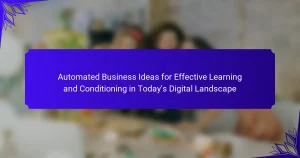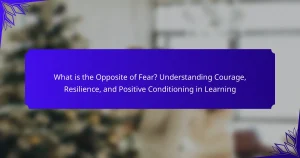Mastering effective learning strategies and conditioning techniques is essential in today’s fast-paced world. This article explores the importance of adaptability, engagement, and self-regulation in learning. It addresses unique challenges learners face, including information overload and varying learning styles. Finally, it highlights practical methods like goal setting, active learning, and time management to enhance retention and productivity.
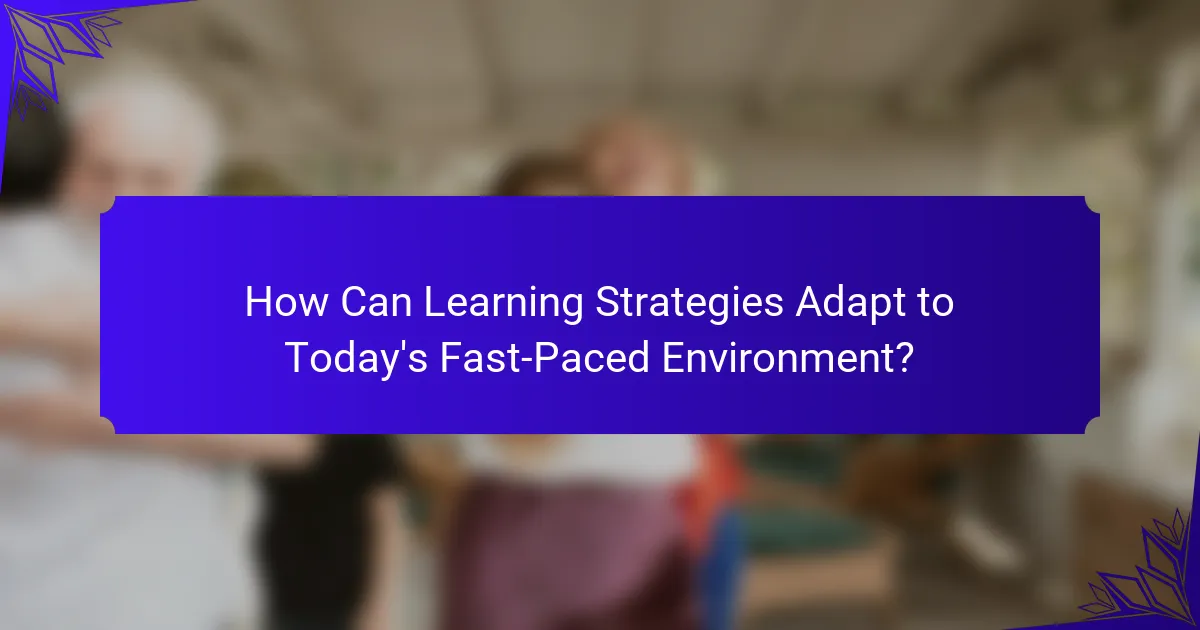
How Can Learning Strategies Adapt to Today’s Fast-Paced Environment?
Learning strategies must be flexible to thrive in today’s fast-paced environment. Effective techniques include prioritizing key concepts, integrating technology, and fostering collaboration. These methods enhance retention and adaptability, ensuring learners can navigate rapid changes. For instance, microlearning breaks down information into digestible segments, promoting engagement and efficiency. Emphasizing self-directed learning empowers individuals to tailor their educational experiences, aligning with personal goals and immediate demands.
What are the key learning strategies effective in modern contexts?
Effective learning strategies in modern contexts include active learning, spaced repetition, and collaborative learning. These approaches enhance retention and engagement, crucial in a fast-paced environment. Active learning involves hands-on activities that promote critical thinking. Spaced repetition optimizes memory retention by revisiting material at intervals. Collaborative learning fosters teamwork and diverse perspectives, enriching the learning experience. Each strategy addresses the unique challenges of today’s educational landscape, ensuring learners adapt and thrive.
What role does technology play in enhancing learning strategies?
Technology significantly enhances learning strategies by providing tools that facilitate personalized education. Adaptive learning platforms, for instance, adjust content based on individual progress, catering to unique learning styles. This customization leads to improved retention rates and engagement. Additionally, technology enables access to vast resources, allowing learners to explore diverse subjects at their own pace. Gamification elements in educational apps further motivate students, making learning interactive and enjoyable. As a result, technology not only supports traditional methods but also introduces innovative approaches that align with the fast-paced demands of today’s world.
How does social media influence learning and conditioning?
Social media significantly enhances learning and conditioning by providing immediate access to diverse information and peer interactions. It fosters collaborative learning environments where users can share insights and resources, promoting deeper understanding. Additionally, social media platforms utilize algorithms that adapt content delivery based on user engagement, reinforcing learning through personalized experiences. This dynamic interaction can lead to improved retention and application of knowledge, making social media a powerful tool in modern educational strategies.
What are the benefits of mastering learning strategies?
Mastering learning strategies enhances cognitive efficiency, improves retention, and fosters adaptability in fast-paced environments. These strategies help individuals manage their time effectively, enabling them to prioritize tasks and reduce stress. Furthermore, they promote a growth mindset, encouraging continuous improvement and resilience in the face of challenges. By employing various techniques, learners can tailor their approaches to suit different subjects or contexts, maximizing their potential for success.
How do conditioning techniques support effective learning?
Conditioning techniques enhance effective learning by reinforcing desired behaviors through consistent rewards and consequences. These strategies create a structured environment that promotes retention and application of knowledge. Techniques such as positive reinforcement boost motivation, while spaced repetition improves memory retention. As a result, learners can adapt to fast-paced environments more efficiently, mastering new skills and concepts effectively.
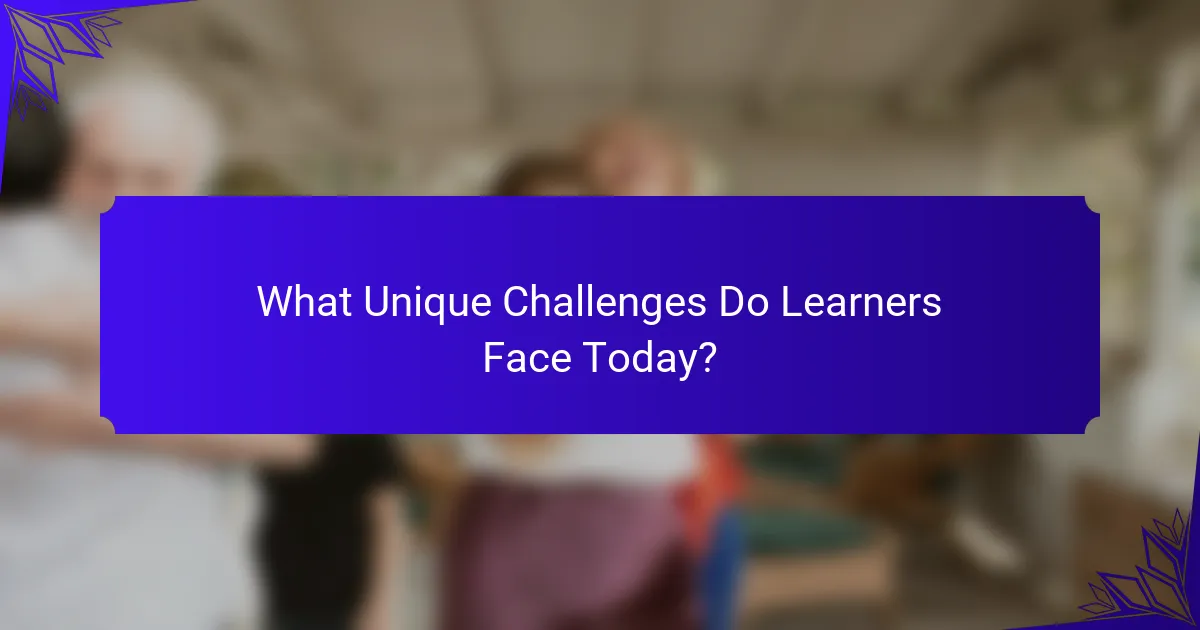
What Unique Challenges Do Learners Face Today?
Learners today face unique challenges that hinder effective education. The rapid pace of technological change demands constant adaptation, making it difficult for learners to keep up. Additionally, increased access to information can lead to information overload, causing confusion and distraction. Social pressures and the prevalence of multitasking further complicate focus and retention of knowledge. Lastly, varying learning styles require personalized strategies, which are often not addressed in traditional educational settings.
How does information overload impact learning effectiveness?
Information overload significantly reduces learning effectiveness by overwhelming cognitive resources. In today’s fast-paced world, learners struggle to focus on essential information due to constant distractions. This leads to decreased retention and comprehension, ultimately hindering mastery of learning strategies. Prioritizing information and employing conditioning techniques can mitigate these effects, enhancing learning outcomes.
What are the psychological barriers to learning in a fast-paced world?
Psychological barriers to learning in a fast-paced world include anxiety, information overload, and lack of motivation. These factors hinder effective learning strategies and conditioning techniques. Anxiety can stem from the pressure to keep up, leading to decreased focus. Information overload occurs when learners face excessive content, making it difficult to prioritize and retain knowledge. A lack of motivation can arise from feeling overwhelmed or disconnected from the material, reducing engagement and retention. Addressing these barriers is essential for mastering learning in today’s environment.
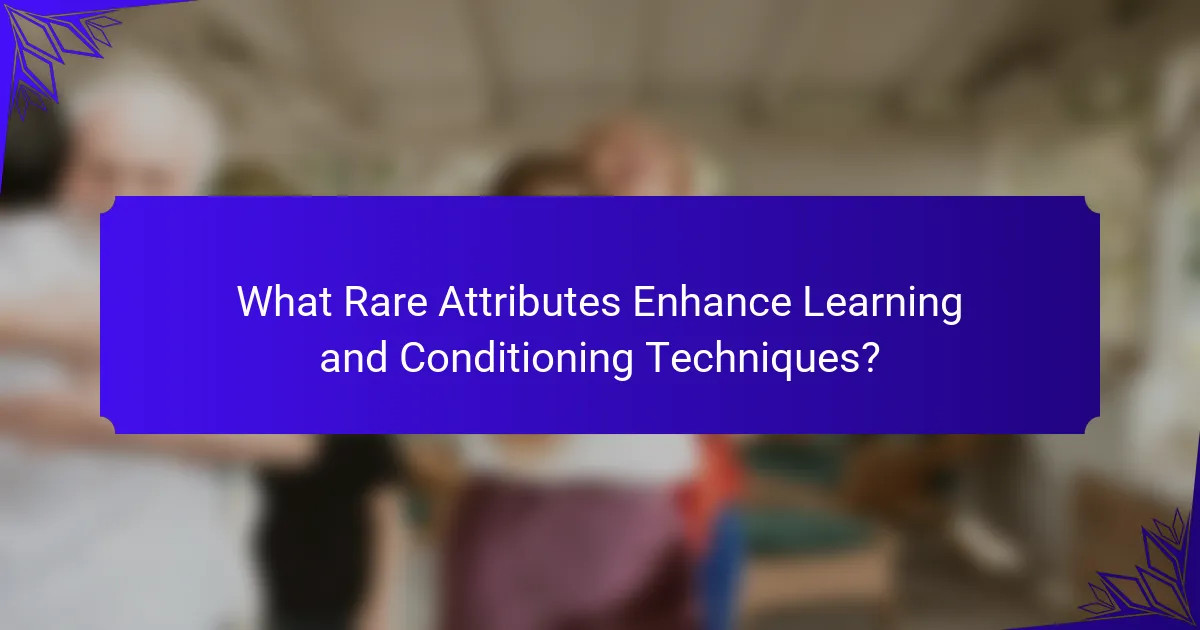
What Rare Attributes Enhance Learning and Conditioning Techniques?
Incorporating rare attributes can significantly enhance learning and conditioning techniques. One rare attribute is adaptability, which allows individuals to adjust their strategies based on feedback and changing environments. Another is metacognition, enabling learners to reflect on their own learning processes, leading to improved self-regulation and effectiveness. Lastly, emotional resilience helps individuals maintain motivation and overcome setbacks, fostering a more robust learning experience.
How can personalized learning enhance retention?
Personalized learning enhances retention by tailoring educational experiences to individual needs. This approach allows learners to engage with content that resonates with their interests and learning styles, leading to deeper understanding. Studies show that personalized strategies can improve retention rates by up to 50%. Additionally, adaptive learning technologies provide real-time feedback, enabling students to master concepts at their own pace. By focusing on unique attributes of each learner, personalized learning fosters motivation and commitment, ultimately enhancing the overall learning experience.
What innovative methods are emerging in learning and conditioning?
Innovative methods in learning and conditioning focus on personalized approaches and technology integration. Techniques like gamification enhance engagement, while adaptive learning platforms tailor content to individual needs. Neurofeedback is emerging as a unique attribute, allowing learners to optimize cognitive functions through real-time brain activity monitoring. Virtual reality simulations provide immersive experiences, facilitating practical skill development in a controlled environment. As a result, these methods improve retention and application of knowledge in today’s fast-paced world.
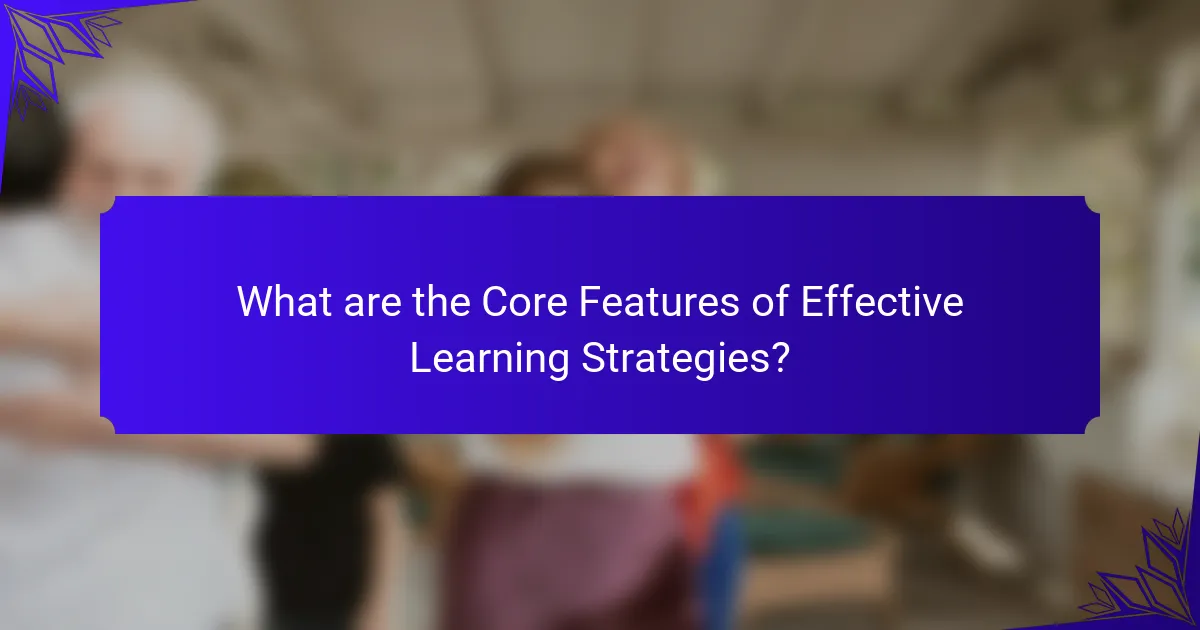
What are the Core Features of Effective Learning Strategies?
Effective learning strategies focus on adaptability, engagement, and self-regulation. Key features include setting realistic goals, employing varied techniques, and fostering a growth mindset. These elements enhance retention and application of knowledge in fast-paced environments. Additionally, integrating feedback loops and self-assessment promotes continuous improvement and mastery of skills.
What role does feedback play in learning?
Feedback is essential in learning as it provides guidance, reinforces understanding, and promotes improvement. It helps learners identify strengths and areas for growth, enhancing their mastery of concepts. Constructive feedback fosters a growth mindset, encouraging persistence and adaptability in today’s fast-paced environment. Regular feedback loops can significantly enhance retention and application of knowledge, making learning more effective and engaging.
How important is goal setting in learning processes?
Goal setting is crucial in learning processes as it provides direction and motivation. Clear goals enhance focus and enable learners to measure progress. Setting specific, measurable, achievable, relevant, and time-bound (SMART) goals fosters accountability. As a result, learners develop effective strategies and conditioning techniques to adapt in fast-paced environments. Research indicates that goal-oriented learners are more likely to achieve desired outcomes.
What are the most effective forms of intake for learning?
Active learning, spaced repetition, and multimodal approaches are the most effective forms of intake for learning. Active learning engages learners through discussion, problem-solving, and hands-on activities, enhancing retention. Spaced repetition optimizes memory by revisiting information at intervals. Multimodal approaches combine visual, auditory, and kinesthetic methods, catering to diverse learning styles. These strategies foster deeper understanding and adaptability in today’s fast-paced world.
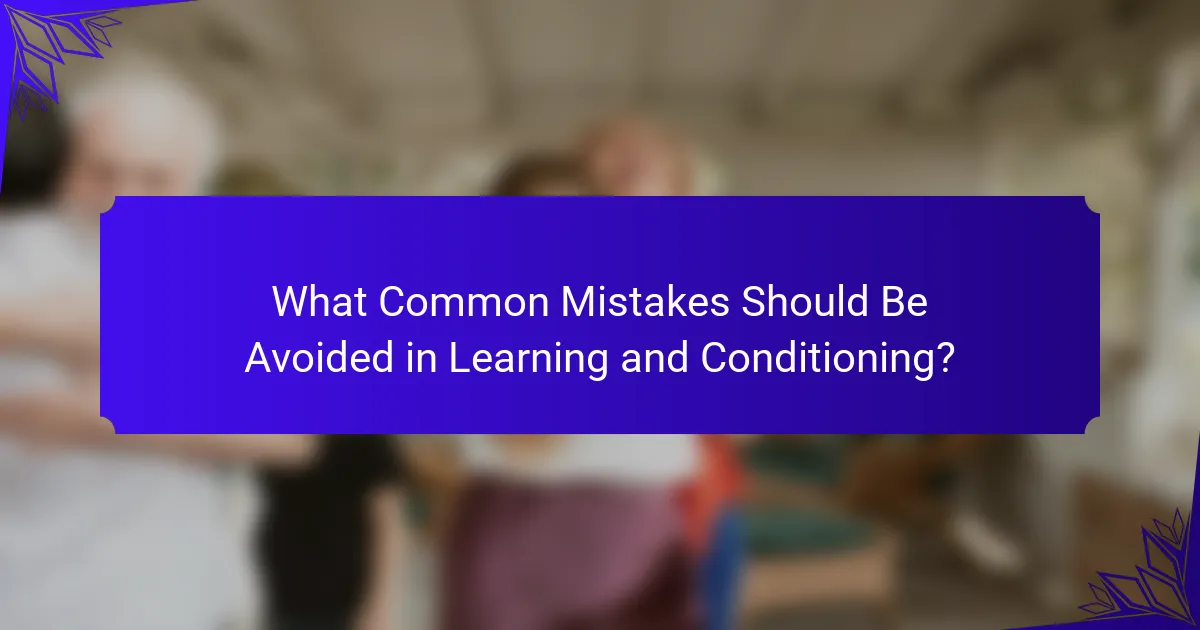
What Common Mistakes Should Be Avoided in Learning and Conditioning?
To enhance learning and conditioning, avoid common mistakes like unrealistic expectations, neglecting individual differences, and underestimating the importance of consistency. Recognizing that mastery takes time is crucial. Additionally, failing to adapt strategies based on feedback can hinder progress. Prioritize setting achievable goals and regularly assess your methods to ensure they align with your learning style.
How can learners avoid the pitfalls of procrastination?
Learners can avoid procrastination by setting realistic goals and breaking tasks into manageable parts. Prioritize tasks based on deadlines and importance. Use time management techniques like the Pomodoro Technique to maintain focus. Establish a consistent routine to create a structured learning environment. Seek accountability through study groups or mentors to stay motivated.
What are the misconceptions about learning styles?
Many misconceptions exist about learning styles, primarily that they dictate how people learn best. Research shows that tailoring methods to learning styles has limited evidence. Instead, effective learning is often about engagement and practice. Another misconception is that individuals can only learn through one style, ignoring the fact that most people benefit from a combination of strategies. Lastly, the belief that learning styles remain static throughout life is misleading; adaptability in learning approaches is crucial for personal growth.
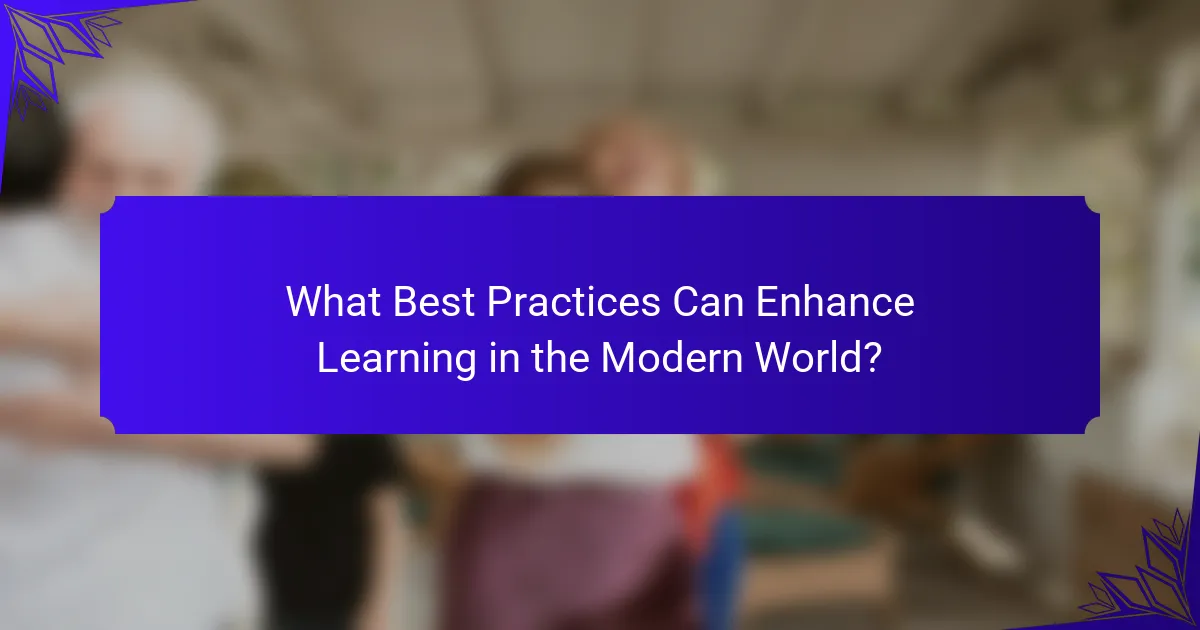
What Best Practices Can Enhance Learning in the Modern World?
To enhance learning in today’s fast-paced world, mastering effective strategies and conditioning techniques is essential. Focus on setting realistic goals, utilizing active learning methods, and fostering a growth mindset.
Incorporate time management techniques, such as the Pomodoro Technique, to maintain focus and productivity. Regularly assess progress and adapt strategies based on feedback.
Engagement through collaborative learning can also deepen understanding and retention. Incorporate diverse resources, including digital tools, to cater to different learning styles.
Lastly, prioritize self-care and mindfulness practices to reduce stress and improve cognitive function, which are crucial for sustained learning.
How can time management improve learning outcomes?
Effective time management significantly enhances learning outcomes by fostering focus, organization, and efficiency. By prioritizing tasks, learners can allocate their time effectively, reducing stress and improving retention. Techniques such as the Pomodoro Technique promote sustained concentration, leading to higher productivity. Furthermore, setting specific goals and deadlines encourages accountability, which is crucial for mastering learning strategies. As a result, learners can adapt to the fast-paced world, achieving better academic performance and personal growth.
What techniques can foster a growth mindset in learners?
Fostering a growth mindset in learners involves techniques that emphasize resilience and adaptability. Key strategies include setting realistic goals, encouraging self-reflection, and promoting a culture of feedback.
1. Set realistic goals: Break down larger objectives into manageable tasks to prevent overwhelm.
2. Encourage self-reflection: Prompt learners to assess their progress and identify areas for improvement.
3. Promote a culture of feedback: Create an environment where constructive criticism is valued and seen as an opportunity for growth.
4. Use positive reinforcement: Acknowledge effort and progress to motivate continued learning.
5. Model a growth mindset: Demonstrate your own learning journey, sharing challenges and successes.
How can learners create a conducive environment for effective conditioning?
Learners can create a conducive environment for effective conditioning by minimizing distractions and establishing a routine. A focused space enhances concentration, while consistent timing fosters habit formation. Incorporating active learning techniques, such as self-testing and spaced repetition, further strengthens retention. Additionally, setting realistic goals helps manage expectations and motivates progress.
